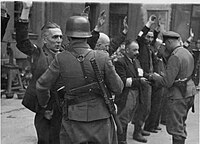Stroop Report

The Stroop Report was an official 75-page report prepared in May 1943 by Jürgen Stroop of the Waffen SS, commander of the German forces which liquidated the Warsaw ghetto, to Heinrich Himmler. It documented the suppression of the Warsaw Ghetto Uprising. Originally titled "The Jewish Quarter of Warsaw is no more!", it is commonly referred to as "The Stroop Report".
The Report was commissioned by Friedrich Krüger, high SS and police leader in Krakow and was intended as a souvenir album for Heinrich Himmler. It was a typed document, bound in black pebble leather, with over 50 photographs accompanied by hand-written Gothic script captions. It consisted of three parts:
- an introduction and summary of SS operations
- a collection of all daily communiqués sent to SS Police Leader East Kruger
- a series of approximately 52 photographs.
The report was prepared in three distinct copies for Heinrich Himmler, Friedrich Krüger and Jürgen Stroop, and all three copies were recovered after the war. The reports, which bear slight discrepancies in textual layout, and in photos they contain, are currently located at the National Archives in Washington D.C., the Bundesarchiv in Koblenz, and the Institute of National Remembrance in Warsaw[1].
One of the copies was introduced as evidence at the International Military Tribunal in Nuremberg. It was first displayed by the chief US prosecutor Robert H. Jackson for the judges during his opening address[2]. The assistant prosecutor dealing with the persecution of the Jews referred to it as "the finest example of ornate German craftsmanship, leather bound, profusely illustrated, typed on heavy bond paper ... the almost unbelievable recital of the proud accomplishment by Major General of Police Stroop."[3]
Photographic captions in the Report are written in the German Sütterlin script.
Photographs from the Stroop Report
-
Nr.1 "The building of the former Jewish Council"
-
Nr.4"The Brauer firm"
-
"The Jewish department heads of the armament firm Brauer"
-
Nr.6 "Forcibly pulled out of dug-outs"
-
"Forcibly pulled out of dug-outs"
-
Nr.7 "To the transshipping place"
-
Nr.8 "Search and interrogation"
-
Nr.9 "Jewish Rabbis"
-
Nr.11
"An assault squad" -
Nr.13 "These bandits resisted by force of arms"
-
"These bandits resisted by force of arms"
-
Nr.14 "Jews pulled from a Bunker"
-
Nr.15 "Bandits"
-
Nr.19 "Smoking out the Jews and Bandits"
-
Nr.21 "Destruction of a housing block"
-
"Fight against a Resistance Pocket"
-
Nr.23 "Hehalutz women captured with weapons"
-
Nr.24 "A housing block being destroyed"
-
Nr.26 no original caption
-
"A woman hangs from a balcony, preparing to drop to the street and the waiting SS."
-
Nr.28 "Securing a street"
-
Nr.31 "Bandits jump to escape capture"
-
Nr.31a "Bandits after having jumped down"
-
Nr.34 "The leader of the grand operation"
-
"Jewish Traitors"
-
"Askaris used during the operation"
See also
References
- ^ United States Holocaust Memorial Museum. photograph #18192.
- ^ International Military Tribunal "Blue Series," Vol. 2, p. 126
- ^ Conot, Justice at Nuremberg, 1983, pp. 269-70.
- ^ The glaring German soldier in photograph Nr.12 has been identified and has a name.










![Nr.12 "Forcibly pulled out of dug-outs" [4]](/media/wikipedia/commons/thumb/0/0b/Stroop_Report_-_Warsaw_Ghetto_Uprising_06b.jpg/200px-Stroop_Report_-_Warsaw_Ghetto_Uprising_06b.jpg)

















